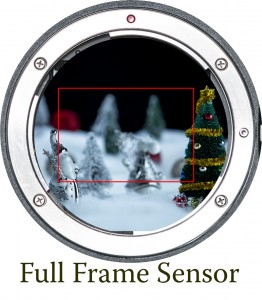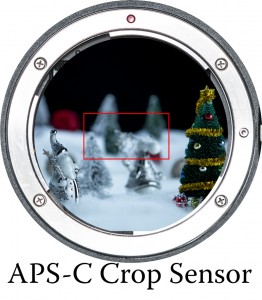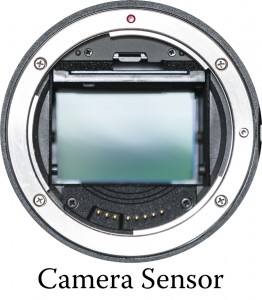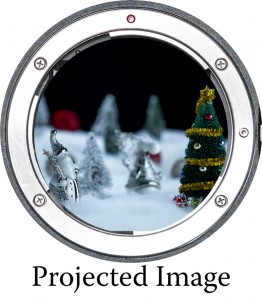There are essentially two kinds of camera bodies from this viewpoint. Full and Crop sensor. Full frame describes a sensor that is the equivalent of classic 35mm film, or 36mm wide by 24mm tall. Crop sensors are somewhat smaller.
This is not a discussion of that is ‘best’ as both have their strengths, though full frame tends to be favored by the professionals for the higher end work.
What does the sensor look like? Well, kinda like this. Here I have locked the mirror up on my 5d mark 2 so you can see the sensor that sits behind the mirror. This is a full frame sensor.
The most noticeable difference, after the price and size, is in the effect the size of the sensor has on the image. To really understand this you need to consider the light going through the lens and being projected on the to camera back, where the sensor resides. Think of the lens as a projector which is shining the scene in front of it on the back of your camera. Technically it is really inverting the image in the process, but this image should still help you visualize this.
So, now the sensor captures a rectangular portion of this image, at which point the size of the image comes into play. 

As you can see, the crop sensor captures a smaller portion of the projected image, which has the effect of magnifying the resulting image. This also affects the width viewable in a wide angle, or a fisheye lens.
Most lenses, unless specifically marked otherwise, are rated against a full frame camera. If it says it is a 50mm lens, then on a full frame camera it will act as a 50mm lens. But put that 50mm lens on a crop sensor body and it can become a 70mm or even a 90mm lens, just because of that crop factor.
Conversely, when buying your lens you need to be sure of which lens you are getting. If you have a crop sensor, anything will generally work fine, though you need to keep the conversion factor in mind. But at least it will not vignette on you (dark corners). If you have a full frame body though a lens not rated for full frame is a risk, as it might not project an image that fills the sensor, or its clarity is unacceptable towards the corners. Such glass generally costs more as the quality of the design needs to be higher.
So, what it comes down to is the same as usual. What is your budget? If cost is the foremost concern, and you have no specific requirement for the very wide angles then a crop sensor body is perfectly good.
Also, one other trivial thing to keep in mind, when you see a picture and they note it was taken with a particular lens, be sure to ask or find out which body it was mounted to, as this will allow you to better understand how the image was made. I was watching a seminar on wedding photography a while back and the presenter kept talking about using a fisheye lens for all his shots. Come to find out he was using a crop sensor body which makes a fisheye lens merely a wide angle lens, so it began to make a little more sense. The 8mm lens was acting more like a 14mm lens. Still very wide, but without the fisheye effect.
For far too many details take a look here: http://en.wikipedia.org/wiki/Crop_factor






